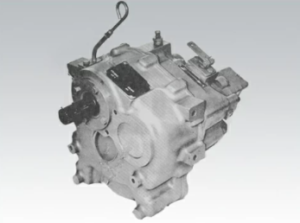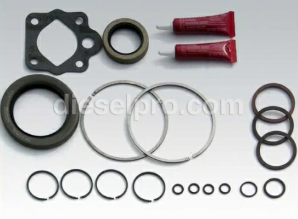
The Twin Disc MG502 Marine Gear is designed for durability and reliable operation in the demanding marine environment. However, when not in use, especially during long-term storage, it is essential to protect the gearbox from environmental damage, corrosion, and mechanical degradation. Proper storage and preservation strategies ensure that the gear system remains in optimal condition, ready for immediate use when needed.
This comprehensive guide provides a 5000-word exploration of the best practices for storing and preserving the Twin Disc MG502, covering long-term storage preparations, preventive measures against environmental damage, and periodic checks during storage. By following these steps, operators can significantly extend the lifespan of their equipment and minimize the risk of unexpected failures.
Long-Term Storage Preparations for Twin Disc MG502 Marine Gear
Storing marine gear for long periods without proper preparation can lead to corrosion, component degradation, and operational failures. Preparing the MG502 correctly ensures its integrity is preserved.
Parts Catalog for Twin Disc MG502 Marine Transmissions
Rebuilt Twin Disc MG502 Marine Transmissions
Bearings For Twin Disc MG502 Marine Transmissions
Plate Kit For Twin Disc MG502 Marine Transmission
Gasket Kits For Twin Disc MG502 Marine Transmission
-
Cleaning the Gear System Before Storage
Cleanliness is critical when preparing the MG502 for storage. Residual contaminants like salt, oil residues, and dirt can accelerate corrosion and mechanical degradation.
A. External Cleaning
- Wash with Fresh Water: Thoroughly wash the exterior of the gearbox with fresh water to remove salt deposits and debris.
- Use a Non-Corrosive Cleaner: Apply a marine-grade degreaser to dissolve stubborn oil and grease.
- Scrub Gently: Use soft-bristle brushes to clean crevices and hard-to-reach areas.
- Dry Completely: Wipe the surface with lint-free cloths and use compressed air to remove moisture from tight spaces.
B. Internal Cleaning
- Drain Old Fluids: Completely drain the gearbox oil, hydraulic fluids, and coolant to remove contaminants.
- Flush the System: Use a non-corrosive flushing fluid to remove any sludge or debris from internal components.
- Inspect for Residual Contaminants: Check internal surfaces for any remaining debris or buildup. Repeat flushing if necessary.
- Dry Internal Components: Use compressed air to remove moisture from internal compartments.
-
Lubrication and Protective Coating
Proper lubrication prevents corrosion and ensures that moving parts remain functional after long-term storage.
A. Lubricating Internal Components
- Apply Protective Oil Coating: Coat gears, bearings, and shafts with a thin layer of marine-grade oil to prevent corrosion.
- Grease Bearings and Bushings: Apply high-quality marine grease to all bearings, bushings, and other friction points.
- Rotate Components: After applying lubricants, manually rotate the shafts to ensure even distribution.
B. External Protection
- Rust Inhibitors: Spray external metal surfaces with corrosion inhibitors.
- Seal with Oil: Apply a light coat of protective oil on exposed bolts and fittings.
- Use Protective Wax: For long-term storage, consider applying a protective wax layer to prevent moisture intrusion.
-
Seal Openings and Ports
Preventing dust, moisture, and pests from entering the gearbox is critical.
- Seal All Openings: Use rubber plugs or sealed caps to close all vents, oil fill ports, and hydraulic line openings.
- Install Desiccant Packs: Place moisture-absorbing desiccant packs inside the gearbox if possible.
- Wrap Sensitive Components: Use moisture-resistant plastic wrapping for critical components like input/output shafts.
-
Environmental Controls for Storage Location
Where and how you store the MG502 will determine its long-term condition.
- Indoor Storage: Store the gearbox indoors in a dry, well-ventilated facility.
- Elevate the Gearbox: Position the gearbox on wooden pallets or metal stands to prevent moisture accumulation.
- Temperature Controls: Maintain a stable temperature to prevent condensation.
- Avoid Direct Sunlight: UV radiation can degrade seals and plastic components.
-
Documentation and Labeling
Proper documentation ensures organized storage and quicker retrieval.
- Label Components: Clearly label the gearbox with the storage date, condition, and any maintenance performed.
- Document Maintenance Procedures: Keep detailed records of the cleaning, lubrication, and sealing steps.
- Attach Instructions: Provide maintenance and operational instructions near the storage location.
Preventive Measures Against Environmental Damage
Even in storage, marine equipment faces risks from moisture, corrosion, and environmental contaminants. Preventive measures are essential to protect the Twin Disc MG502 from these threats.
-
Protection Against Moisture and Humidity
Moisture is the leading cause of corrosion in metal components.
- Use Dehumidifiers: In storage areas, use dehumidifiers to maintain optimal humidity levels.
- Silica Gel Packs: Place silica gel packs inside the gearbox housing to absorb residual moisture.
- Regular Air Circulation: Ensure good ventilation in storage areas to prevent moisture buildup.
- Anti-Corrosion Sprays: Regularly spray the external parts with anti-corrosion sprays during storage.
-
Prevention of Dust and Dirt Contamination
Dust and dirt can cause abrasive wear and contamination when the gearbox is reactivated.
- Use Protective Covers: Cover the gearbox with a waterproof, dust-resistant material.
- Sealed Storage Cabinets: Store smaller components and sensitive parts in sealed containers.
- Limit Foot Traffic: Minimize foot traffic around the stored equipment to reduce dust accumulation.
-
Pest Control Measures
Pests like rodents and insects can damage wiring and seals.
- Pest Deterrents: Place non-toxic pest deterrents around storage areas.
- Seal Gaps and Entry Points: Ensure that storage areas are free from gaps where pests can enter.
- Regular Inspections: Periodically inspect the storage site for pest activity.
-
UV Protection
UV radiation can degrade rubber seals and cause cracking.
- Store Indoors: Always prioritize indoor storage to eliminate UV exposure.
- UV-Protective Coatings: Apply UV-resistant sprays to exposed rubber components.
- Cover with UV-Resistant Materials: Use UV-resistant tarps for outdoor storage.
Periodic Checks During Storage
Periodic inspections during storage are critical for ensuring the continued integrity of the Twin Disc MG502. Early detection of issues can prevent costly repairs and extend equipment life.
-
Monthly Visual Inspections

Gasket and seal kit for Twin Disc marine transmission MG502.
Performing monthly checks helps catch early signs of environmental damage.
- Check for Leaks: Look for any signs of oil, hydraulic fluid, or grease leaks.
- Inspect Seals and Gaskets: Check for any deterioration or cracking of external seals.
- Visual Check for Corrosion: Look for signs of rust or corrosion on metal surfaces.
-
Quarterly Maintenance Checks
Every three months, conduct a deeper inspection and maintenance routine.
- Rotate Shafts Manually: This prevents bearings from seizing and distributes lubricants evenly.
- Inspect Protective Coatings: Reapply corrosion inhibitors or oil coatings as needed.
- Check Moisture Levels: Replace desiccant packs and inspect for any moisture buildup.
- Inspect Covers and Wrappings: Ensure that protective coverings are intact and secure.
-
Annual Preservation Maintenance
Annual checks are critical for gearboxes in extended storage.
- Drain and Replace Fluids: If applicable, replace any fluids that have degraded during storage.
- Deep Clean External Surfaces: Remove dust, debris, and any contaminants that may have settled.
- Inspect Bearings: Check for smooth rotation and replace grease if necessary.
- Re-Apply Protective Coatings: Ensure all exposed surfaces are properly coated to prevent corrosion.
- Documentation Update: Record all inspections and actions taken during maintenance.
-
Preparing for Re-Commissioning
When preparing to bring the MG502 back into service, a thorough inspection is necessary.
- Remove Protective Covers: Carefully remove all seals, plugs, and coverings.
- Inspect for Damage: Check for any damage sustained during storage.
- Flush and Replace Fluids: Replace all lubricants and hydraulic fluids to ensure optimal performance.
- Test Clutch and Gear Engagement: Verify smooth operation before re-installation.
Conclusion
Proper storage and preservation of the Twin Disc MG502 Marine Gear are critical to maintaining its operational integrity and extending its service life. Whether storing the gearbox for a season or several years, meticulous preparation and routine checks prevent environmental damage, corrosion, and costly repairs.
Key Takeaways for Optimal Storage:
- Comprehensive Preparation: Clean, lubricate, and seal all components before storage.
- Environmental Control: Protect against moisture, UV radiation, pests, and contaminants.
- Regular Inspections: Conduct monthly, quarterly, and annual inspections to identify and resolve issues promptly.
- Detailed Documentation: Maintain detailed records of all preservation and maintenance actions.
By following these comprehensive storage and preservation strategies, marine operators can ensure that the Twin Disc MG502 is always ready for reliable operation when needed, minimizing downtime and maximizing longevity.

Parts Catalog for Twin Disc MG502 Marine Transmissions
Rebuilt Twin Disc MG502 Marine Transmissions
Bearings For Twin Disc MG502 Marine Transmissions
Plate Kit For Twin Disc MG502 Marine Transmission
Gasket Kits For Twin Disc MG502 Marine Transmission



 Free US Calls: 1-888-433-4735
Free US Calls: 1-888-433-4735 International: 305-545-5588
International: 305-545-5588